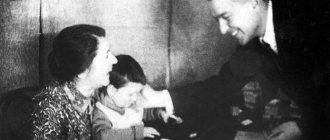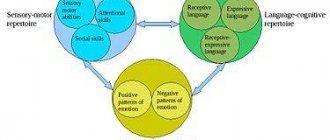Lev Semyonovich Vygotsky (1896 – 1934)
is a world-famous Soviet psychologist and teacher, whose works include research into the psychology and cognitive development of children.
For some time, a real cult of Vygotsky was developing in the USSR and throughout the world, which resulted in his “debunking” carried out in recent years, often based on distortions and falsifications of his real works and ideas.
Life and work of a domestic scientist
The biography of this famous person begins in 1896 - on November 17, a boy named Lev Vygotsky was born in one of the large families in the city of Orsha. A year later, the Vygotsky family moves to Gomel, where the boy’s father (a former bank employee) opens a library.
The future innovator studied science at home as a child. Lev, like his brothers and sisters, was taught by Solomon Markovich Ashpiz, whose teaching methods differed significantly from traditional ones. Practicing Socratic teachings, which were hardly used in the educational programs of that time, he established himself as a very remarkable personality.
By the time Vygotsky needed to enter higher education, he already knew several foreign languages (including Latin and Esperanto). Having entered the medical faculty of Moscow University, Lev Semenovich soon submitted a request to be transferred to another faculty to study jurisprudence. However, while mastering jurisprudence simultaneously at two faculties of different educational institutions, Vygotsky nevertheless came to the conclusion that the legal profession was not for him, and completely delved into the comprehension of philosophy and history.
The results of his research were not long in coming. Already in 1916, Lev wrote his first creation - an analysis of the drama “Hamlet” by William Shakespeare. The author later presented the work, which took up exactly 200 pages of handwritten text, as a thesis.
We recommend: Pedology is
Like all subsequent works of the Russian thinker, the innovative two-hundred-page analysis of Shakespeare's Hamlet aroused keen interest among specialists. And it’s not surprising, because in his work Lev Semenovich used a completely unexpected technique that changed the usual understanding of the “tragic story of the Danish prince.”
A little later, as a student, Lev began to actively write and publish literary analyzes of works by Russian writers - Andrei Bely (B.N. Bugaev), M.Yu. Lermontov.
L.S. Vygotsky graduated from universities in 1917 and after the revolution moved with his family to Samara, and then to Kyiv. But after some time they all return to their hometown, where young Vygotsky gets a job as a teacher.
In a brief summary, the thinker’s life upon returning to his homeland can be summarized in a few sentences (although Wikipedia offers a much more detailed version): he works in schools, teaches at technical schools and even gives lectures, trying himself as an editor in a local publication. At the same time, he heads the theater and art education departments.
However, the young teacher’s serious practical work in the teaching and scientific fields began around 1923-1924, when at one of his speeches he first spoke about a new direction in psychology.
early years
Lev Semenovich Vygotsky (real name Lev Simkhovich Vygodsky) was born in 1896 in the Belarusian city of Orsha, where his parents’ family was forced to live beyond the Pale of Settlement. Soon they moved to Gomel, Mogilev province. At the end of the 19th century, this city was a center of trade and industry.
Vygotsky's parents valued education, had a broad outlook, and tried to instill in their children a love of art and science. The best family recreation was reading and trips to the theater.
Young Lev's first teacher, Solomon Ashpiz, an activist in the Social Democratic Party, encouraged his students to develop free thinking through Socratic dialogue. Even before entering the gymnasium, Lev learned English, Hebrew and Ancient Greek, and later Latin, French, Esperanto and German were added to them.
After successfully completing his gymnasium studies, Lev Vygotsky intended to study philology at Moscow University, but was refused. At that time, Jews could not freely choose their specialty. Then Vygotsky entered medical school. And then he transferred to the Faculty of Law. In addition, he attended lectures on psychology and philosophy from G. Shpet and P. Blonsky at the People's University, and after 1917 he completely transferred there.
Developmental education
For the first time in Russian psychology, Vygotsky began to study the relationship between learning and human development. By the term “development” he understood gradual changes in the physiology, behavior and thinking of a child. They occur over time under the influence of the environment and natural processes in the body.
Changes are taking place in several areas:
- Physical – changes in the structure of the brain, internal organs, motor and sensory skills.
- Cognitive - in mental processes, mental abilities, imagination, speech, memory.
- Psychosocial – in personal behavior and emotions.
These areas develop simultaneously and are interconnected. There is a need to draw up an approximate schedule for the appearance of specific forms of behavior in children. Lev Semenovich Vygotsky developed the doctrine of age as a central problem in theoretical psychology. As well as teaching practice.
In subsequent years, Soviet scientists V. Davydov, P. Galperin, M. Enikeev and others, based on the theories of L. S. Vygotsky about the psychology of child development, developed the concept of developmental education. That is, the scientist’s works were continued by his followers.
Personal-active approach
Lev Semenovich Vygotsky believed that human personality is formed in the process of complex interaction with the environment. There is no unmotivated activity. Its motive comes from a certain need. The mental development of an individual is aimed at the formation of internal actions aimed at achieving conscious goals.
Vygotsky’s personality theory puts the student himself, his goals, motives, and individual psychological characteristics at the center of the learning process. The teacher determines the direction and methods of teaching based on the interests and perspectives of the child.
Development and education of special children
Vygotsky developed a new theory of abnormal child development, on which defectology is now based and all practical correctional pedagogy is built. The purpose of this theory: the socialization of special children with a defect, and not the study of the defect itself. It was a revolution in defectology.
He connected special correctional pedagogy with the pedagogy of a normal child. He believed that the personality of a special child is formed in the same way as that of ordinary children. It is enough to socially rehabilitate an abnormal child, and his development will follow the normal course.
His social pedagogy was supposed to help the child remove the negative social layers caused by the defect. The defect itself is not the cause of the child’s abnormal development, it is only a consequence of improper socialization.
The starting point in the rehabilitation of special children should be an unaffected state of the body. “We should work with the child based on what is healthy and positive,” Vygotsky.
By starting rehabilitation, you can also start the compensatory capabilities of the special child’s body. The idea of the zone of proximal development has become very effective in restoring the normal development of special children.
Quotes
- “A child needs never-before-seen things only when he is well established in the past.”
- “Tragedy is a riot of maximum human strength, therefore it is major.”
- “Man is always full of unfulfilled possibilities.”
- “Having the end of the path, it is easiest to understand both the entire path as a whole and the meaning of the individual stages.”
- “The execution of an automatic act does not give our mind any task. There is no difficulty, which means there is no need, and therefore there is no consciousness.”
Dissemination and popularity of Vygotsky's ideas
After the death of Lev Semenovich, his works were forgotten and did not spread. However, since 1960, pedagogy and psychology have rediscovered Vygotsky, revealing many positive aspects in him.
His idea of the zone of proximal development helped assess learning potential and proved fruitful. Her outlook is optimistic. The concept of defectology has become very useful for correcting the development and education of special children.
Many schools have adopted Vygotsky’s definitions of age standards. With the advent of new sciences (valeology, correctional pedagogy, a new reading of previously perverted pedology), the scientist’s ideas became very relevant and fit into the concept of modern education, a new democratic school.
Many of Vygotsky’s ideas are being popularized here and abroad today.
Michael Cole and Jerome Bruner incorporated them into their theories of development.
Rome Harré and John Shotter considered Vygotsky the founder of social psychology and continued his research.
In the 90s Valsiner and Barbara Rogoff deepened developmental psychology based on Vygotsky's ideas.
Vygotsky's students were prominent Russian psychologists, including Elkonin, who also worked on problems of child development. Together with teachers, based on Vygotsky’s ideas, he created an effective Elkonin-Davydov-Repkin development program.
It is used to teach mathematics and language according to a special system; it is approved by the state and is now widely used in schools.
In addition, there are still many talented hypotheses and unrealized ideas of Vygotsky that are waiting in the wings.
Influence on the development of science
In world psychology, Vygotsky’s theory of the cultural and historical development of personality gained popularity in the 70s, when the scientist’s books began to be published in the West. Many works have appeared devoted to the understanding and development of his ideas.
American and European psychologists use Vygotsky's findings to develop methods for learning foreign languages and even researching modern computer technologies. In the context of cultural-historical theory, the possibilities of new forms of learning are considered: distance learning and electronic learning. Scientists D. Parisi and M. Mirolli proposed using the achievements of the Soviet psychologist to give robots more “human” features.
In Russia, Vygotsky’s theories were developed and reinterpreted by his students and followers. Among them are outstanding scientists P. Galperin, A. Leontiev, V. Davydov, A. Luria, L. Bozhovich, A. Zaporozhets, D. Elkonin.
In 2007, Cambridge University Press published a major study of the works of L. S. Vygotsky. Scientists from ten countries, including Russia, took part in its creation.
Unified Labor School
It was the prototype of a democratic school based on a creative, dynamic, collaborative pedagogy. It was ahead of its time, imperfect, and made mistakes, but it was still successful.
Vygotsky’s ideas were implemented by teachers Blonsky, Wenzel, Shatsky and others.
The pedological theory was tested at the school:
· psychological and pedological diagnostic rooms operated;
· constant medical and psychological monitoring was carried out;
· classes were created according to the principle of the child’s pedological age.
This school existed until 1936, when the Soviet authorities began attacking it. The school was repurposed as a regular one.
The very idea of pedology was distorted, and it fell into oblivion. Pedology and the idea of a labor school received a second life in the 90s. with the collapse of the USSR. A unified labor school in the modern sense is a democratic school, very appropriate in today's education.
Cultural-historical theory. The essence
Vygotsky's basic psychological theory began to take shape with his early publications in journals and took its final form in the 1930s. The scientist insisted on considering the social environment in which the child is located as the main factor in personality development.
Lev Semenovich believed that the reason for the crisis of contemporary psychology was that researchers considered only the primitive side of human consciousness, while ignoring higher functions. He distinguished two levels of behavior:
- natural, involuntary, formed through the evolution of biological processes;
- cultural, based on the historical development of human society, controlled.
Vygotsky believed that consciousness has a sociocultural, symbolic nature. Signs are formed by society in a historical context and influence the restructuring of the child’s mental activity. The scientist argued that speech is the most important factor in psychological development. It unites the physical, cultural, communicative and semantic levels of consciousness.
Higher psychological functions with the help of signs (mainly speech) are adopted from the outside and only then become part of a person’s inner world. Vygotsky developed the concept of a social situation of development. It can be stepwise, evolutionary or crisis.
Levels
In the theory of developmental development, Vygotsky identified two important levels. Let's look at them:
- Zone of current development. This is the child’s level of available preparedness, those tasks that he is able to complete without help from adults.
- Zone of proximal development. It includes tasks that the child cannot solve on his own, only with the help of an adult. However, through interaction with other people, the child gains the necessary experience and subsequently becomes able to perform the same actions independently.
According to Vygotsky, learning should always go ahead of development. It should be based on the age stages that have already been passed and focus on the functions that have not yet been fully formed, the potential capabilities of the child.
The most important factor in a child’s development is cooperation with an adult. Moreover, learning occurs not only at school, but also in everyday life and in the family.
Innovative ideas and concepts of the teacher
Vygotsky deeply studied issues of child psychology. Perhaps because he himself loved children very much. And not only our own. A sincere kind-hearted man and a teacher from God, he knew how to empathize with the feelings of other people and was condescending towards their shortcomings. Such abilities led the scientist to defectology.
Vygotsky considered the “defects” identified in children to be only physical limitations that the child’s body tries to overcome at the level of instincts. And this idea is clearly demonstrated by the concept of Vygotsky, who believed that the duty of psychologists and teachers is to help children with disabilities in the form of support and providing alternative ways to obtain the necessary information and communicate with the outside world and people.
Child psychology is the main area in which Lev Semenovich carried out his activities
He paid special attention to the problems of education and socialization of special children
We recommend: What is a development zone?
The domestic thinker made a great contribution to the organization of children's education, drawing up a special program that makes it possible to explain the development of psychological health through the connections of the body with the environment. And precisely because it was possible to most clearly trace internal mental processes in children, Vygotsky chose child psychology as the key area of his practice.
The scientist observed trends in the development of the psyche, exploring the patterns of internal processes in ordinary children and in patients with anomalies (defects). In the course of his work, Lev Semenovich came to the conclusion that the development of a child and his upbringing are interconnected processes. And since the science of pedagogy dealt with the nuances of upbringing and education, the domestic psychologist began research in this area. This is how an ordinary teacher with a law degree became a popular child psychologist.
Vygotsky's ideas were truly innovative. Thanks to his research, the laws of personality development were revealed in the context of specific cultural values, deep mental functions were revealed (the book Vygotsky “Thinking and Speech” is dedicated to this) and the patterns of mental processes in a child within the framework of his relationship with the environment.
The ideas proposed by Vygotsky became a solid foundation for correctional pedagogy and defectology, which makes it possible to provide assistance to children with special needs in practice. Pedagogical psychology currently uses many programs, systems and developmental methods, which are based on the scientist’s concepts of the rational organization of upbringing and education of children with developmental anomalies.
Culture determines the psyche
If we continue the analogy, it was precisely these factors that determine the final appearance of the house that Lev Semenovich Vygotsky was interested in. The main works of the researcher: “Psychology of Art”, “Thinking and Speech”, “Psychology of Child Development”, “Pedagogical Psychology”. The scientist's range of interests clearly shaped his approach to psychological research. A person passionate about art and linguistics, a gifted teacher who loves and understands children is Lev Nikolaevich Vygotsky. He clearly saw that it was impossible to separate the psyche and the products it produced. Art and language are products of the activity of human consciousness. But they also determine the emerging consciousness. Children do not grow up in a vacuum, but in the context of a certain culture, in a linguistic environment that has a great influence on the psyche.
VYGOTSKY LEV SEMENOVICH
Lev Semenovich (1896–1934) – psychologist, professor (1928). He graduated from Moscow University (1917) and at the same time from the A.L. Shanyavsky People's University. Since 1924, he worked in scientific and educational institutions in Moscow (Institute of Psychology, AKV named after N.K. Krupskaya, pedagogical faculty of the 2nd Moscow State University, etc.). He began his scientific activity by studying the psychology of art - he studied the psychological laws of perception of literary works (“Psychology of Art”, 1925, publ. 1965). He gave a critical analysis of world psychology in the 1920s-30s, which played an important role in the development of domestic psychological science (“Historical meaning of the psychological crisis,” 1927, published in Sobr. soch., vol. 1, M., 1982). He created a general psychological concept known as the “cultural-historical theory of the psyche,” in which he revealed the socio-historical nature of consciousness and higher mental functions (“History of the development of higher mental functions,” Collected Works, vol. 3, M., 1983)
This theory was important for the psychology of learning. According to it, the structure of social interaction “adult – child”, presented in expanded form in the so-called zone of proximal development of the child, is subsequently acquired by him and forms the structure of mental functions
This determines the relationship between training and development: training “leads” development, and not vice versa. He formulated the problem of age in psychology, proposed a variant of periodization of child development based on the alternation of “stable” and “critical” ages, taking into account the mental neoplasms characteristic of each stage. Studied the stages of development of children's thinking; in a polemic with J. Piaget, he proved that speech is social both in origin and in function (“Thinking and Speech,” Collected Works, vol. 2, M., 1982). He created a new direction in defectology, showing the possibility of compensating for a defect through the development of higher mental functions. He developed a new doctrine about the localization of mental functions in the cerebral cortex. He created a large scientific school, among his students A.V. Zaporozhets, A.N. Leontiev, A.R. Luria. D.B. Elkonin and others.
Works: Collected Works, vol. 1–6. – M., 198284; Pedagogical psychology, - M., 1991.
Lit.: Scientific creativity of L.S. Vygotsky and modern psychology. – M., 1981; Bubbles A.A. Cultural-historical theory of L.S. Vygotsky and modern psychology. – M., 1986; Leontyev A.A. L.S. Vygotsky. – M., 1990; Stepanov S.S. Century of psychology: names and destinies. – M., 2002. – P. 259–271.
Rate the definition:
—
Bibliography - a treasure trove of works by an outstanding psychologist
Throughout his life, the domestic thinker and teacher, who later became a psychologist, not only carried out practical activities, but also wrote books. Some of them were published during the scientist’s lifetime, but there are also many works published posthumously. In total, the bibliography of the classic of Russian psychology includes more than 250 works in which Vygotsky presented his ideas, concepts, as well as the results of research in the field of psychology and pedagogy.
We recommend: K. D. Ushinsky: biography
The following works of the innovator are considered the most valuable:
Vygotsky L.S. “Educational Psychology” is a book that presents the basic concepts of the scientist, as well as his ideas regarding solving the problems of raising and teaching schoolchildren, taking into account their individual abilities and physiological characteristics
While writing this book, Lev Semenovich focused his attention on studying the connection between psychological knowledge and the practical activities of teachers, as well as on research into the personality of schoolchildren
“Collected works in 6 volumes”: volume 4 – a publication that covers the main issues of child psychology. In this volume, the outstanding thinker Lev Semenovich proposed his famous concept, which defines sensitive periods of human development at different stages of his life. Thus, the periodization of mental development, according to Vygotsky, is a graph of the child’s development in the form of a gradual transition from the moment of birth from one age level to another through zones of unstable development.
“Psychology of Human Development” is a fundamental publication that combines the works of a domestic scientist in several areas: general, educational and developmental psychology. For the most part, this work was devoted to organizing the activities of psychologists. The ideas and concepts of Vygotsky’s school presented in the book became the main reference point for many contemporaries.
We recommend: Subject and tasks of pathopsychology
“Psychology” is a collection of works published under a single title, which presents the answers of the authoritative psychologist Vygotsky to the most pressing questions of teachers and students studying the relevant scientific field.
“Fundamentals of Defectology” is a book in which the teacher, historian and psychologist Vygotsky outlined the main provisions of this scientific direction, as well as his famous theory of compensation. Its essence lies in the fact that each anomaly (defect) has a dual role, since, being a physical or mental limitation, it is also a stimulus for the initiation of compensatory activity.
These are just some of the works of the outstanding scientist. But believe me, all his books deserve close attention and represent an invaluable source for many generations of domestic psychologists. Vygotsky, even in the last years of his life, continued to implement his ideas and write books, while simultaneously working on the creation of a specialized department of psychology at the Moscow All-Union Institute of Experimental Medicine.
Carier start
It was with this speech that the career of the young scientist began. Vygotsky was invited to the Moscow Institute of Experimental Psychology. Outstanding psychologists of that time - Leontyev and Luria - already worked there. Vygotsky not only organically fit into this scientific team, but also became an ideological leader, as well as an initiator of research.
Soon, practically every practicing psychotherapist and defectologist knew who Lev Semenovich Vygotsky was. The main works of this outstanding scientist will be written later, but at that time he was a brilliant practitioner for everyone, personally engaged in pedagogical and therapeutic activities. Parents of sick children made incredible efforts to get an appointment with Vygotsky. And if you managed to become an “experimental sample” in the laboratory of anomalous childhood, it was considered an incredible success.
Principles of raising children according to Vygotsky
The scientist believed that education does not consist in adapting the child to the environment, but in the formation of a personality that goes beyond this environment, as if looking forward. At the same time, the child does not need to be educated from the outside, he must educate himself.
This is possible with proper organization of the education process. Only the personal activity of a child can become the basis of education.
The teacher should only be an observer, correctly guide and regulate the child’s independent activity at the right moments.
Thus, education becomes an active process from three sides:
· the child is active (he performs independent actions);
· the teacher is active (he observes and helps);
· The environment between the child and the teacher is active.
Education is closely related to learning. Both processes are collective activities. The structure of the new labor school, which Vygotsky created with his students, is based on the principles of the collective process of education and training.
Psychology of pedagogy
Most of Lev Semenovich Vygotsky’s works are devoted to the study of the psychological patterns of human development that arise in the process of upbringing and training. The term “pedology” is also used to denote this field of knowledge.
Education in psychology refers to the development of human abilities, the transfer of skills and knowledge. Education means working with personality and behavior. This is the area of feelings and relationships between people. Educational psychology has a close connection with sociology and physiology.
Scientific works
While still a student, Vygotsky began publishing articles on literature and Jewish culture in magazines. He was published a lot in the magazines “New Life”, “New Path” and in Gorky’s “Chronicle”
The psychologist paid great attention to the problem of anti-Semitism in Russian literature
After the revolution, Vygotsky left his legal career. He collaborated with Gomel newspapers and magazines and wrote theater reviews. Lev Semenovich taught logic and literature in schools and technical schools, and gave lectures on psychology. The experience of working in educational institutions became a serious impetus for the scientist. Which prompted him to decide to develop psychological theories in pedagogy.
A long-standing interest in culture prompted the creation of one of his most significant works. We are talking about Vygotsky’s book “Psychology of Art”. It was written as a dissertation and was first published only in 1965.
Another seminal work was called “Educational Psychology.” The author analyzed his own teaching experience and developed his scientific theories on its basis. In later works “Thinking and Speech” and “Teachings on Emotions” these ideas find their continuation.
Among the legacy of L. S. Vygotsky are books, monographs, and scientific articles. He managed to publish many works that began to fall under the ban of the Soviet regime during his lifetime. After the death of the scientist, his works were removed from libraries and declared illegal.
Vygotsky's theories found new life only in the late fifties. And after the publication of books abroad, the scientist gained worldwide fame. Until now, his scientific concepts arouse admiration and controversy among his colleagues.
Main directions of Vygotsky's research
Vygotsky was, first and foremost, a psychologist. He chose the following areas of research:
· comparison of adults and children;
· comparison of modern man and ancient man;
· comparison of normal personality development with pathological behavioral deviations.
The scientist drew up a program that determined his path in psychology: to look for an explanation of internal mental processes outside the body, in its interaction with the environment. The scientist believed that these mental processes can only be understood through development. And the most intensive development of the psyche occurs in children.
This is how Vygotsky came to an in-depth study of child psychology. He studied the patterns of development of normal and abnormal children. In the process of research, the scientist came to study not only the process of child development, but also his upbringing. And since pedagogy is the study of education, Vygotsky began research in this direction.
He believed that any teacher should base his work on psychological science. This is how he connected psychology with pedagogy. And a little later, a separate science in social pedagogy emerged - psychological pedagogy.
While engaged in pedagogy, the scientist became interested in the new science of pedology (knowledge about the child from the point of view of various sciences) and became the main pedologist of the country.
He put forward ideas that revealed the laws of cultural development of the individual, his mental functions (speech, attention, thinking), explained the internal mental processes of the child, his relationship with the environment.
His ideas on defectology laid the foundation for correctional pedagogy, which began to practically help special children.
Vygotsky did not develop methods for raising and developing children, but his concepts of the proper organization of education and upbringing became the basis of many developmental programs and systems. The scientist’s research, ideas, hypotheses and concepts were far ahead of their time.
Work with children
Perhaps it was sincere kindness, the ability to deeply feel other people and treat their shortcomings with condescension that led Vygotsky to defectology. He always maintained that limited abilities in one thing are not a death sentence for a child. The flexible child's psyche actively seeks opportunities for successful socialization. Dumbness, deafness, blindness are just physical limitations. And the child’s consciousness instinctively tries to overcome them. The main responsibility of doctors and teachers is to help the child, push him and support him, and also provide alternative opportunities for communication and obtaining information.











